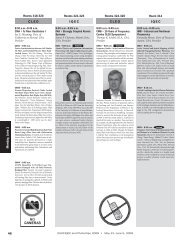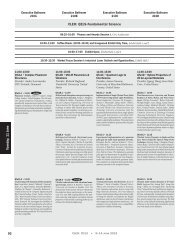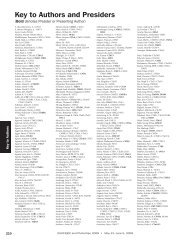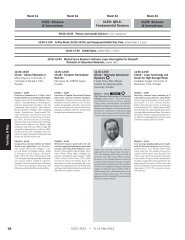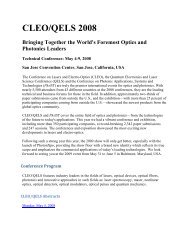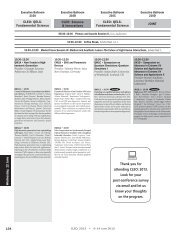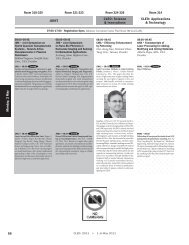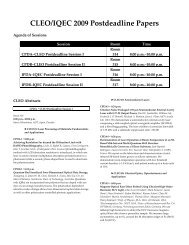Tuesday, 3 May 2011 - CLEO
Tuesday, 3 May 2011 - CLEO
Tuesday, 3 May 2011 - CLEO
You also want an ePaper? Increase the reach of your titles
YUMPU automatically turns print PDFs into web optimized ePapers that Google loves.
Room 339 Room 340<br />
Room 341<br />
<strong>CLEO</strong>: Science<br />
& Innovations<br />
16:00–17:45<br />
CTuY • Organic Emitters and<br />
Absorbers<br />
Kristjan Leosson, Univ. of Iceland,<br />
Iceland, Presider<br />
16:00–17:45<br />
CTuZ • Optofluidic Photonic<br />
Structures and Devices<br />
Anders Kristensen, Technical<br />
Univ. of Denmark, Denmark,<br />
Presider<br />
16:00–17:45<br />
CTuAA • Nanostructured<br />
Materials and Devices<br />
Peter Kazansky, Univ. of<br />
Southampton, UK, Presider<br />
CTuY1 • 16:00 Invited<br />
Melt-grown molecular mono-crystals: morphology,<br />
optical properties, role of the substrate,<br />
Silvia Tavazzi 1 , Stefano Mora 1 , Peter Spearman 1 ;<br />
1<br />
Materials Science Department, Univ. of Milano<br />
Bicocca, Italy. Molecular mono-crystals can be<br />
grown and integrated in devices from the melted<br />
compound. The role of the substrate and the resulting<br />
morphology, crystallinity, optical anisotropy<br />
and properties are discussed.<br />
CTuZ1 • 16:00<br />
Porous Polymer Waveguides and Ring Resonators,<br />
Matthew Mancuso 1 , Julie Goddard 2 , David<br />
Erickson 3 ; 1 Department of Biomedical Engineering,<br />
Cornell Univ., USA; 2 Department of Food Science,<br />
Univ. of Massachusetts Amherst, USA; 3 Sibley<br />
School of Mechanical and Aerospace Engineering,<br />
Cornell Univ., USA. Nanoporous polymer ring<br />
resonators are capable of detecting biomolecular<br />
interactions within their pores. These interactions<br />
between the core energy and biomolecules lead to<br />
increased sensitivity when compared to traditional<br />
ring resonators.<br />
CTuAA1 • 16:00<br />
Femtosecond Laser-Assisted Etching of Three<br />
Dimensional Woodpile Micro-Channel Arrays<br />
in Fused Silica, Stephen Ho 1 , Moez Haque 1 , Peter<br />
R. Herman 1 , J. Stewart Aitchison 1 ; 1 Edward S.<br />
Rogers Sr. Department of Electrical and Computer<br />
Engineering and the Inst. for Optical Sciences, Univ.<br />
of Toronto, Canada. A three-dimensional invertedwoodpile<br />
micro-channel array was fabricated in<br />
bulk fused silica with femtosecond laser and HF<br />
etching. An exposure compensation algorithm<br />
provided uniform periodic woodpile structure<br />
defining a novel micro-channel.<br />
CTuZ2 • 16:15<br />
Tunable Single Mode Lasing from an On-chip<br />
Optofluidic Ring Resonator Laser, Wonsuk Lee 1,2 ,<br />
Hao Li 1,3 , Jonathan D. Suter 1 , Karthik Reddy 1,2 ,<br />
Yuze Sun 1 , Xudong Fan 1 ; 1 Biomedical Engineering,<br />
Univ. of Michigan, USA; 2 Electrical Engineering and<br />
Computer Science, Univ. of Michigan, USA; 3 Optical<br />
Science and Engineering, Fudan Univ., China. We<br />
demonstrate single mode lasing from coupled<br />
OFRRs via the Vernier effect with a threshold of<br />
a few µJ/mm 2 . The single mode operation is stable<br />
under high pump densities, and its wavelength<br />
can be tuned.<br />
CTuAA2 • 16:15<br />
Formation of laser-induced periodic structures<br />
in TiO 2 crystals depending on the surface quality,<br />
Susanta K. Das 1 , Marcus Rohloff 1 , Andreas<br />
Pfuch 2,3 , Wolfgang Seeber 2 , Arkadi Rosenfeld 1 ,<br />
Ruediger Grunwald 1 ; 1 Max Born Inst. for Nonlinear<br />
Optics and Short-Pulse Spectroscopy, Germany;<br />
2<br />
Friedrich-Schiller-Universität Jena, Germany;<br />
3<br />
INNOVENT e.V. Technologieentwicklung Jena,,<br />
Germany. The formation of femtosecond laser<br />
induced periodic surface structure in TiO 2 crystals<br />
significantly depends on surface quality. Higher<br />
roughness shifts ripple formation towards lower<br />
fluence and lower pulse number and improve<br />
structural coherence.<br />
CTuY2 • 16:30<br />
Low-threshold lasing in organic semiconductor<br />
microcones, Tobias Grossmann 1,2 , Sönke Klinkhammer<br />
3,2 , Mario Hauser 1 , Torsten Beck 1 , Karl Lüll 3 ,<br />
Dominik Floess 1 , Christoph Vannahme 2,3 , Timo<br />
Mappes 2 , Uli Lemmer 3 , Heinz Kalt 1 ; 1 Institut für<br />
Angewandte Physik, Karlsruhe Inst. of Technolog,<br />
Germany; 2 Inst. for Microstructure Technology,<br />
Karlsruhe Inst. of Technology, Germany; 3 Light<br />
Technology Inst., Karlsruhe Inst. of Technology,<br />
Germany. We report on the fabrication and optical<br />
characterization of whispering-gallery microcavity<br />
lasers with an organic semiconductor gain<br />
layer and laser thresholds as low as 1 nJ per pulse,<br />
operating at visible wavelengths.<br />
CTuZ3 • 16:30<br />
Plasmonic Mach-Zehnder interferometer on<br />
a microfluidic chip for sensitive optical sensing,<br />
Yongkang Gao 1 , Qiaoqiang Gan 1 , Xuanhong<br />
Cheng 2 , Filbert Bartoli 1 ; 1 Center for Optical<br />
Technologies, Electrical and Computer Engineering<br />
Department, Lehigh Univ., USA; 2 Materials Science<br />
and Engineering Department, Lehigh Univ., USA.<br />
We demonstrate a plasmonic Mach-Zehnder<br />
interferometer on a microfluidic chip for sensitive<br />
optical sensing with an enhanced sensitivity of<br />
more than 4200nm/RIU observed with a far-field<br />
optical microscope.<br />
CTuAA3 • 16:30<br />
Bragg spectral response of femtosecond laser<br />
induced nanogratings inside fused silica glass,<br />
Jianzhao Li 1 , Moez Haque 1 , Peter R. Herman 1 ; 1 Electrical<br />
and Computer Engineering, Univ. of Toronto,<br />
Canada. Bragg spectral response of femtosecond<br />
laser induced nanogratings has been observed<br />
for the first time, offering a convenient, fast and<br />
quantitative approach to characterize nanogratings<br />
for better understanding of ultrafast laser<br />
glass interactions.<br />
<strong>Tuesday</strong>, 3 <strong>May</strong><br />
CTuY3 • 16:45<br />
Directional Photoluminescence Enhancement<br />
in Organic Flexible Microcavities, Luca Frezza 2 ,<br />
Maddalena Patrini 1 , Marco Liscidini 1 , Davide Comoretto<br />
2 ; 1 of Physics A. Volta, Univ. of Pavia, Italy;<br />
2<br />
Dipartimento di Chimica e Chimica Industriale,<br />
Univ. of Genova, Italy. We report on the fabrication<br />
and full optical characterization of flexible full<br />
plastic 1D photonic crystal cavities. We demonstrate<br />
strong directional emission enhancement<br />
when the emitting layer is resonantly coupled to<br />
the cavity mode.<br />
CTuZ4 • 16:45<br />
Plasmonic Nano-Apertures for Lensfree Onchip<br />
Sensing, Bahar Khademhosseinieh 1 , Gabriel<br />
Biener 1 , Ikbal Sencan 1 , Ting-Wei Su 1 , Ahmet F.<br />
Coskun 1 , Aydogan Ozcan 1 ; 1 Electrical Engineering,<br />
Univ. of California at Los Angeles, USA. We demonstrate<br />
lensfree on-chip sensing within a microfluidic<br />
channel using plasmonic nanoapertures<br />
illuminated by a partially-coherent source. Our<br />
results confirm lensfree sensing of refractive index<br />
changes as small as ~0.002 using this modality.<br />
CTuAA4 • 16:45<br />
Freezing ultrashort light pulses by excitonpolariton<br />
interference in glass, Martynas Beresna<br />
1 , Peter Kazansky 1 , Thomas Taylor 2 , Alexey<br />
Kavokin 2 ; 1 Optoelectronics Research Centre, Univ. of<br />
Southampton, UK; 2 Physics and Astronomy School,<br />
Univ. of Southampton, UK. Nanostructures with<br />
sub-wavelength period along polarization and<br />
close to wavelength along propagation direction<br />
self-assemble in silica glass after femtosecond laser<br />
writing. Phenomenon is interpreted in terms of<br />
exciton-polariton crystal formation.<br />
Concurrent sessions are grouped across four pages. Please review all four pages for complete session information.<br />
115



